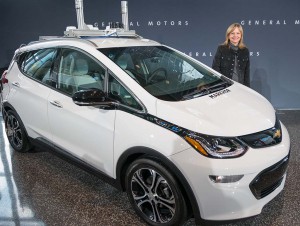For more than a century, General Motors defined the “old boys network,” and while it long made GM the largest and most powerful automaker on the planet, by 2009 it helped drive the automaker into bankruptcy.
It took a federal bailout to keep Detroit’s largest automaker alive. But it’s GM’s first woman chief executive – indeed, the first female CEO at any major carmaker – who is forcing the company to abandon its shopworn playbook.
The latest evidence comes with the announcement on Monday that GM will shutter three North American assembly plants, as well as two powertrain facilities, while slashing 15% of its white-collar workforce. It’s all part of a move, according to Barra, that will see it shift away from the sort of cars and trucks it has been building for more than 100 years and focus on the electrified and autonomous vehicles many experts believe will dominate tomorrow’s transportation industry.
“We recognize the need to stay in front of changing market conditions and customer preferences to position our company for long-term success,” Barra said during a media teleconference.
(General Motors shuttering Canadian plant. Click Here for the story.)
Raised in a GM family, Barra graduated from what was then known as the General Motors Institute, spending summers as a factory floor co-op student. She worked her way up and into management, eventually becoming a top lieutenant to Chairman and CEO Dan Akerson, one of two outsiders who managed GM after its bankruptcy. In January 2014, Barra took over, initially as CEO and soon after adding the chairman’s title. And she has made it clear that her agenda doesn’t read, “business as usual.”
“In contrast to times past, General Motors, under CEO Mary Barra, is trying to get ahead of a potential crisis by making cuts now,” said Michelle Krebs, executive analyst, Autotrader.com.
“A confluence of factors has triggered GM’s actions: a downturn in the important China market as well as a potential downturn in the North American market – the two are GM’s biggest markets; the dramatic shift by consumers from traditional cars to utility vehicles; and the impact of tariffs and trade issues.”
Barra, who turns 57 next month, has demonstrated that in a variety of ways, including her decision to pare back a company that long was guided by the principle, growth at all cost. For one thing, GM has sharply cut back on the hefty incentives it long used to prop up its market share in the U.S. market – often at the expense of its bottom line.
Globally, the automaker has pulled out of a number of money-losing markets, including Russia and South Africa, and taken the unusual decision to stop selling product in India, while continuing to run its low-cost factories there for export. Perhaps the most striking example of how Barra has been willing to walk permanently away from the chase for global sales leader came with the decision to sell the long-struggling Opel-Vauxhall. The German-based subsidiary is now owned by France’s PSA.
“Mary Barra is pushing GM into the 21st century by proactively up-ending nearly every part of the U.S. business and its global operations, positioning the company to be more flexible, agile, and streamlined,” said Rebecca Lindland, an executive analyst with Kelley Blue Book.
The plant closures are the latest shift Barra has authorized. It apparently was prompted by several factors, including the ongoing U.S. shift from traditional passenger cars to light trucks. Most of the products impacted by the announcement are slow-selling sedans like the Chevrolet Cruze and Cadillac XTS.
But Barra and company are also positioning the announcement as part of a broader strategy shift that focuses on electrified and autonomous vehicles.
“GM now intends to prioritize future vehicle investments in its next-generation battery-electric architectures,” the automaker said in a Monday news release. “As the current vehicle portfolio is optimized, it is expected that more than 75% of GM’s global sales volume will come from five vehicle architectures by early next decade.”
(Click Here for more about GM looking at white collar layoffs due to low buyout response.)
GM’s push into electrification and autonomy have led Barra to make other significant moves, notably including her willingness to form alliances with erstwhile rivals.
In January 2017, it announced a partnership with Honda to develop and build fuel-cell systems. The two launched a second venture this autumn that will see Honda ultimately invest about $2.75 billion to develop self-driving vehicles. That will include a $750 million stake in Cruise Automation, its autonomous vehicle research subsidiary.
Barra isn’t the only one willing to shake things up. Indeed, Ford Motor Co., announced an even more radical plan earlier this year, CEO Jim Hackett declaring the company will abandon passenger cars almost entirely – with the sole exception of the Mustang in the U.S. market. And Ford is establishing a major new campus in Detroit’s Corktown neighborhood specifically focused on electrified and autonomous vehicles.
“GM is actually a tad late to adjusting its product line and production capacity to the dramatic car to utility shift,” Krebs said. “Ford and Fiat Chrysler already revealed their plans to largely abandon traditional cars. We had expected GM to follow suit, especially in light of 2019’s labor talks with the UAW.”
Nonetheless, Barra is pushing hard to steer a battleship that, historically, has plowed forward even when icebergs appeared on the horizon.
Of course, such a huge transformation has both its risks and its costs.
The plant closures and job cuts come “at a tremendous cost to people and the communities which depend upon GM plants for economic sustainability,” said analyst Lindland.
(To see more about GM’s plans, Click Here.)
But Barra clearly believes that doing business as usual will have an even higher cost, long-term.




“It’s all part of a move, according to Barra, that will see it shift away from the sort of cars and trucks it has been building for more than 100 years and focus on the electrified and autonomous vehicles many experts believe will dominate tomorrow’s transportation industry.”
Experts (and CEOs)are usually wrong, especially about the future and sometimes even the past….
The news of car “unallocated” production begs the question: What exactly ARE GM’s plans for electrified products? All we have heard so far are vague descriptions and numbers. How about specifics? Now would be a good time.